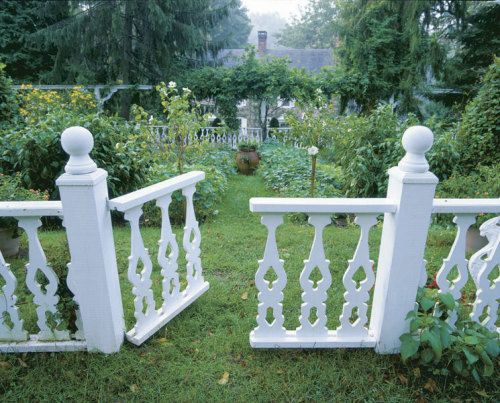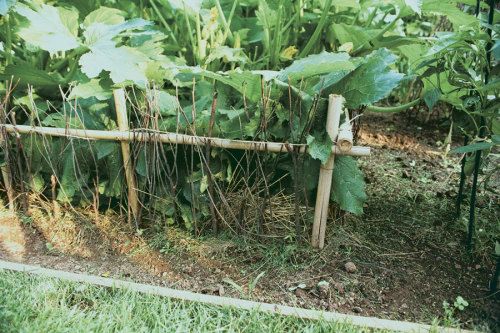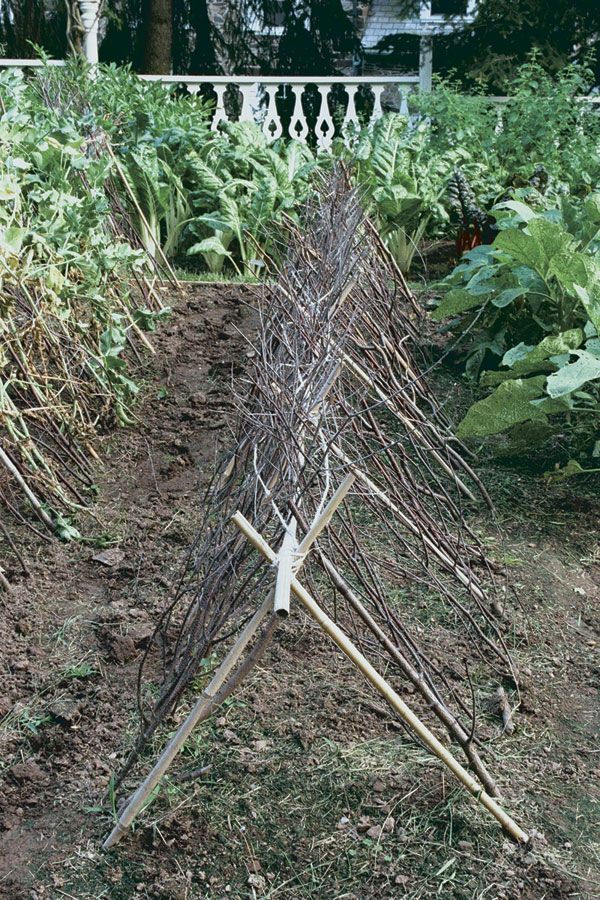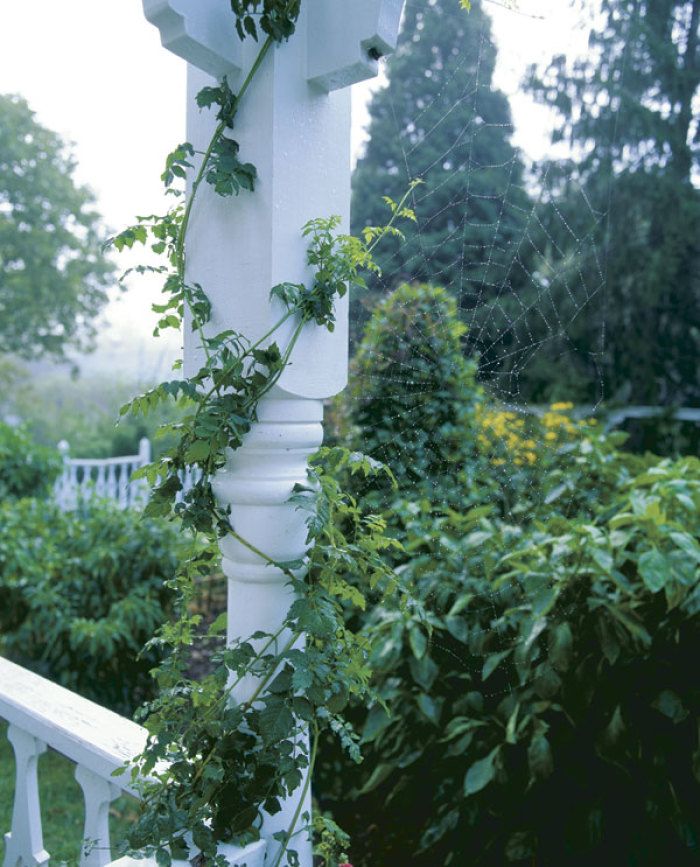
by Jack Staub
June 1996
from issue #3
My vegetable garden is my haven. After a strenuous week’s work in New York City, I head for my garden on an 18th-century farmstead in Bucks County, Pennsylvania. The simple, methodical pleasures of planting, picking, and hoeing are the perfect balm to my city-worn brain. It’s peaceful and quiet here—quiet, that is, until the many ducks, geese, and peafowl I keep come around to strike up a conversation with me.
The design of the garden is very basic, but the effect is anything but boring. There are four rectangular beds surrounded by grass paths and enclosed in a fence to keep the ducks and geese out. I’ve found plenty of opportunities to make the garden beautiful, from the vaguely Victorian design of the fence and arbors, to the homemade English-style plant supports, to the fat strawberry jar that sits in the middle of the garden. And when I’m faced with a challenge, I try to come up with a solution that is not only horticulturally sound but also pleasing to the senses.
The garden is on the only fairly level, open space available—across a drive from the house and up a short, steep hill. Somehow I had to connect the garden to the house physically and visually. To make access easy, I laid a flight of steps up the center of the steep bank, using old Philadelphia curbstones as treads. Off to one side, another smaller flight of steps curves up to a gate at the garden’s west end. This path is handy to the kitchen door, so I can easily run up to harvest vegetables and herbs.
To complete the visual connection and to anchor the vegetable garden in the landscape, I made an entry garden on the bank by planting small conifers and a few other ornamentals. I thinned out the vivid pink phlox which threatened to take over, but there’s enough remaining to put on a fine midsummer show. Although you can’t see into the garden from the ground floor of the house, the second-story windows look directly at it—a charming sight from the upstairs bedrooms and office.
Succeeding as a weekend gardener
Being at the garden only on weekends places some limitations on me. Since I’m not around much to catch potential problems, I try to avoid them. I don’t grow root vegetables—there are simply too many below-ground pests. I also avoid full-size cabbage, although I’ve been able to harvest good heads of a short-season, miniature savoy cabbage. I’ve learned to make smaller sowings of quick-to-bolt crops like broccoli raab, because I may have only one weekend of harvest. I favor mild-tasting lettuces like ‘Rouge d’Hiver’, ‘Capitane’, ‘Romance’, and ‘Merveille de Quatre Saisons’ because, when they do bolt, their leaves aren’t too bitter to enjoy. And ‘Blue Lake’ is a great pole bean for me because the pods taste good even when they get large.
I look for varieties that are attractive as well as productive. I enjoy the finely cut leaves of mizuna and frisée endive. I have peppers that ripen not only to green or red, but also to lilac, ivory, and orange. And I always have chard, both ruby and white, for its fine show.
New Zealand spinach is the most successful new crop I’ve grown in years. A midsummer planting lasted until frost, unbothered by disease or pests. It is pretty, delicious raw or cooked, and crisp even in the hottest weather. Malabar spinach is another pseudo-spinach that does fine in the heat. This vining plant has big, crinkly leaves that really taste like spinach.
Making the underpinnings part of the show
Pole beans are one of my favorite crops, and I love the architectural look of a bean teepee. One I’d seen on a visit to England inspired me to create my own version at home. The basic structure is made of bamboo, and then “thatched” with a layer of birch branches, which were readily available from a grove on our property. Any fairly straight-limbed branch will do, though. After overlaying the birch, I bind the whole thing together with twine so the branches don’t pull away from the bamboo skeleton as the beans start to take hold. The thatched teepees lend a Cotswolds effect to the garden, and are lovely even bare.
I’ve also made low, running A-frames from the same three elements. These are good for lower growing climbers like snap peas, which don’t need the height of a teepee. Come fall, I bundle up the stakes, twigs, and twine from each structure and store them individually, so they’re ready for service next year.
As every vegetable gardener knows, squash can be extremely unruly in a small garden. After several years of enduring large, encroaching leaves and sprawling vines, I applied the same bamboo-and-twig technique to create a “playpen.” I marked off an area 6 ft. by 12 ft. and drove short bamboo stakes into the ground at each corner and every 2 ft. along the sides. To complete the frame, I bound long bamboo canes horizontally around the top of each side with twine. Then I “planted” birch twigs all along the outer perimeter. I bound the twigs to the top of the frame by weaving twine in and out from one vertical cane to the next.
Finally, I gave the twigs a haircut with garden shears to make the top edge uniform. Inside the pens, six hills of summer squash play very nicely together and don’t disturb their garden neighbors.
Blue ribbon gardening
In the early years, I never took myself very seriously as a vegetable gardener. Then about eight years ago, I entered some of my produce in the local fair. It started as a lark, but surprisingly, I won some ribbons. Now I do it every year, and I have a ball. For each entry, I have to bring not one but several perfect and matching specimens. Everybody, from grandmothers to five-year-olds, takes part, and it’s a very neighborly affair. I have to admit, though, when I come home with a fistful of ribbons, I’m totally gleeful to have won.
My garden is an unending source of delight. I never tire of the wonder that I can grow what I eat. I continue to marvel that those tiny seeds will produce that startling head of broccoli, or that perfect row of crisp romaine, or that majestic pyramid of beans covered with pods and flowers. But one of the principal joys of my garden is finding ways to marry the utilitarian with the aesthetic. To solve problems with imagination and vision. To grow my dinner and have something beautiful to look at.
Fine Gardening Recommended Products

The Crevice Garden: How to make the perfect home for plants from rocky places
Fine Gardening receives a commission for items purchased through links on this site, including Amazon Associates and other affiliate advertising programs.

Berry & Bird Rabbiting Spade, Trenching Shovel
Fine Gardening receives a commission for items purchased through links on this site, including Amazon Associates and other affiliate advertising programs.

Corona E-Grip Trowel
Fine Gardening receives a commission for items purchased through links on this site, including Amazon Associates and other affiliate advertising programs.

























Comments
Log in or create an account to post a comment.
Sign up Log in